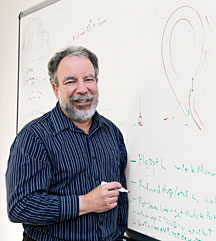- Number 371 |
- September 10, 2012
Scientist finds new way to predict heat layer troublemaker

PPPL's Rob Goldston.
Researchers at a recent worldwide conference on fusion power have confirmed the surprising accuracy of a new model for predicting the size of a key barrier to fusion that a top scientist at DOE’s Princeton Plasma Physics Laboratory (PPPL) has developed. The model could serve as a starting point for overcoming the barrier. “This allows you to depict the size of the challenge so you can think through what needs to be done to overcome it,” said physicist Robert Goldston, the Princeton University professor of astrophysical sciences and former PPPL director who developed the model.
Goldston was among physicists who presented aspects of the model in late May to the 20th Annual International Conference on Plasma Surface Interactions in Aachen, Germany. Some 400 researchers from around the world attended the conference. Results of the model have been “eerily close” to the data, said Thomas Eich, a senior scientist at the Max Planck Institute for Plasma Physics in Garching, Germany, who gave an invited talk on his measurements. The agreement appears too close to have happened by chance, Eich added.
Goldston’s model predicts the width of what physicists call the “scrape-off layer” in tokamaks, the most widely used fusion facilities. Such devices confine hot, electrically charged gas, or plasma, in powerful magnetic fields. But heat inevitably flows through the system and becomes separated, or scraped off, from the edge of the plasma and flows into an area called the divertor chamber.
The challenge is to prevent a thin and highly concentrated layer of heat from reaching and damaging the plate that sits at the bottom of the divertor chamber and absorbs the scrape-off flow. Such damage would halt fusion reactions, which take place when the atomic nuclei, or ions, inside the plasma merge and release energy. “If nothing was done and you took this right on the chin, it could be a knockout blow,” said Goldston, who published his model in January in the journal Nuclear Fusion.
Solving this problem will be vital for future machines like ITER, the world’s most powerful tokamak, which the European Union, the United States and five other countries are building in France to demonstrate fusion as a source of clean and abundant energy. The project is designed to produce 500 megawatts of fusion power in 400 second-long pulses, which will require researchers to spread the scrape-off heat as much as possible to protect the divertor plate. [Read the story.]
[Kitta MacPherson, 609.243.2755,
kittamac@pppl.gov]
